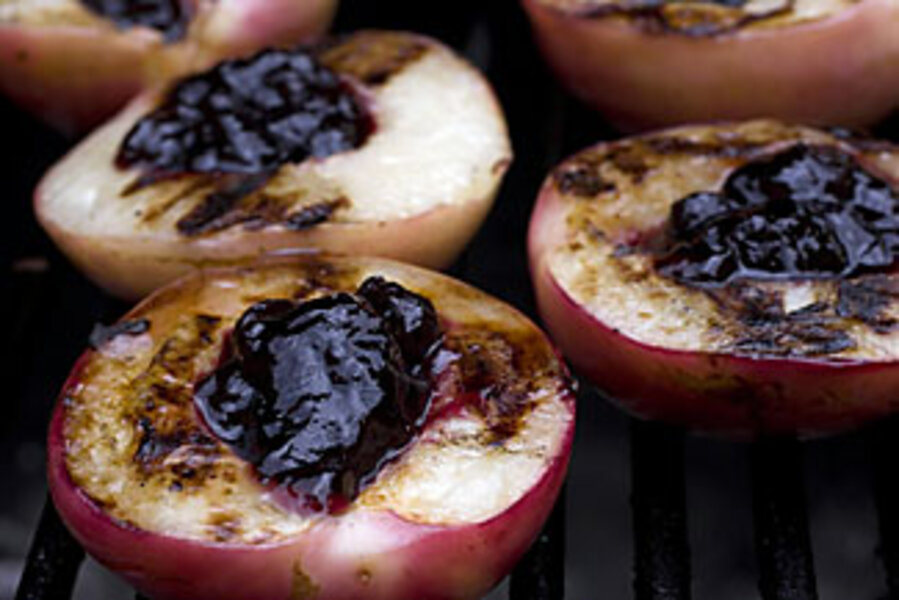Put your fruit to the fire
Loading...
Venture a guess what your neighbor will be cooking on his backyard grill this coming Labor Day weekend, and fruit is probably the last thing that comes to mind. Burgers and dogs, for sure; a salmon steak, maybe; and peppers and onions, perhaps; but strawberries, nectarines, or mangoes? Doubt it.
"Many people still think grilling is only about a hunk of meat," says Steven Raichlen, host of the PBS series "The Primal Grill" and author of many bestselling books on barbecue. "Grilling fruit is the last frontier – in America at least." He explains that in some parts of the world, especially Southeast Asia, grilled fruit is ubiquitous on every street corner.
Mr. Raichlen and other grilling gurus wonder why it's not more common to put fruit to the fire here. They say that fruits, especially those that are most succulent – pineapple, peaches, nectarines, plums, and mangoes – are an ideal match for cooking over flames, as grilling caramelizes fruits' natural sugars, producing an outstanding flavor.
The simplicity of grilling fruit also adds to its appeal. It's certainly easier to throw a few peach slices on the fire than to make and bake a peach cobbler, especially if the rest of the meal is produced on the grill, too. The host can avoid the heat of the kitchen all night, and typically, one can create a memorable dish by merely brushing the fruit with melted butter or olive oil and sprinkling it with a bit of sugar and cinnamon.
In her latest cookbook, "Grill Every Day," Diane Morgan devotes an entire chapter to grilled fruit, which she has enjoyed for years not only as a dessert served with vanilla ice cream, for example, but also in savory dishes such as salads or alongside grilled pork or chicken.
Some of her favorite simple recipes are sliced pineapple and peaches, which she first brushes with butter and sprinkles with cinnamon; and also figs, which she likes to drizzle with olive oil before grilling and serves with a cheese course or in a salad with green beans and a shallot vinaigrette.
Pineapple is also a favorite of Raichlen's. "Pineapples taste particularly good grilled," he says, "the charred flavor meshing nicely with the caramelized sweetness of the fruit."
When buying pineapple, he advises, "look for fruit with a golden rind. It will be juicier and sweeter than the usual green-rind pineapples."
We can thank Hawaii and its luau tradition for interest in grilled pineapple, says Karen Adler, co-author with Judith Fertig of 13 barbecue books. But Ms. Adler likes to venture beyond this Hawaiian classic. She grills apples, mangoes, papayas, kiwis, oranges, and more, always experimenting with new recipes and techniques. She has simplified her method by grilling fruit on only one side.
"That way," she says, "one side will be crisp and the other caramelized, and it takes half the time!"
Three to four minutes is all that's needed to grill fruit, Adler says, as long as it is almost ripe when it's put to the flames. "I like a hot fire, just hot enough so I can get enough sizzle."
She recommends grilling fruit uncovered, unless it's underripe and needs to soften. And she doesn't always grill tidy, well-proportioned slices. Instead, Adler might thread a skewer with pieces of a variety of fruits, including whole strawberries, which look great on the plate. She also likes to fiddle with different sauces, especially butter or vegetable oil and a mix of fresh herbs, transforming the fruit into a savory dish. For presentation, she might thread the fruit onto a rosemary branch.
There is perhaps no end to innovation when it comes to grilling fruit. Even these accomplished authors keep going back to learn more, putting fruit to the flames and experimenting with imaginative ways to enhance its natural sweetness.
"Heat and sweet work in interesting ways, which is why grilled fruit works so well," says Raichlen, adding what has practically become his motto: "If something tastes good baked, fried, or sautéed, it probably tastes better grilled."
Grilled Sugar-Dipped Pineapple
1 ripe pineapple
8 tablespoons (1 stick) unsalted butter, melted
3/4 cup sugar
1 teaspoon grated lime zest
1 teaspoon ground cinnamon
1/8 teaspoon ground cloves
Preheat the grill to high.
Cut the leafy top off the pineapple, then cut off the rind. Slice the fruit into 8 or 10 even rounds. Using a pineapple corer or paring knife, remove the core from each round.
When ready to cook, place the melted butter in a shallow bowl; combine the sugar, lime zest, cinnamon, and cloves in a separate bowl. Bring both bowls grillside.
Oil the grill grate. Dip each slice of pineapple first in melted butter, then in the sugar mixture, shaking off excess.
Grill the slices, turning with tongs, until browned and sizzling,
5 to 8 minutes per side.
Transfer the pineapple slices to plates or a platter, arranging the slices in an overlapping fashion.
Serves 8 to 10.
– From 'The Barbecue Bible!' by Steven Raichlen (Workman Publishing)
Grilled peaches
4 firm peaches (or substitute pears or apples, or do a medley of fruit
Prepare and preheat the grill to medium-high.
Peel peaches and cut in half (remove the pit). Grill about 4 minutes per cut side.
If desired, serve with caramel sauce or a sprinkling of brown sugar. Or fill centers with a spoonful of blueberry preserves (see photo). A side of homemade vanilla or peach ice cream would be terrific, too.
Serves 4.
– From 'The Best Little Grilling Cookbook,' by Karen Adler (CelestialArts/Ten Speed Press)





